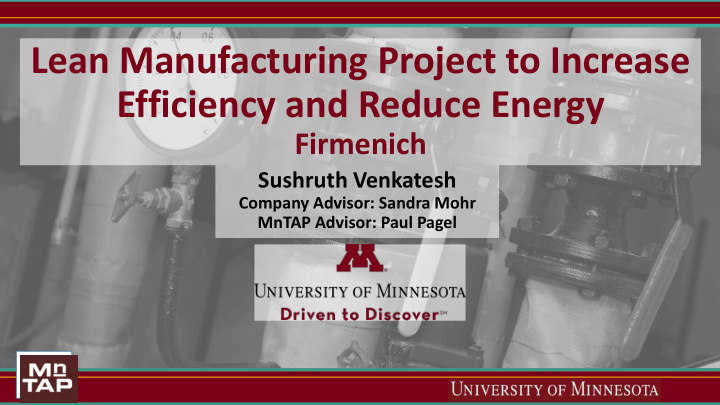



Lean Manufacturing Project to Increase Efficiency and Reduce Energy Firmenich Sushruth Venkatesh Company Advisor: Sandra Mohr MnTAP Advisor: Paul Pagel
Company Overview • Started in 1895 • World’s largest private company in the flavors & fragrances business • Producer of liquid, dry, and encapsulated flavors • 64 countries, 54 operational facilities, 26 manufacturing sites • New Ulm, MN location is one of five in the US • Spray-dried, dry-blended, paste, and liquid flavors
Incentives for Change • Lean manufacturing • Continuous improvement • Corporate sustainability
Reasons for MnTAP Assistance • 40% of all products are spray-dried powders • Increase efficiency of spray drying operation (increase up-time) • Increase production capacity (continue expansion and leadership in market) • Continue march towards sustainability goals • Constantly strive to be a good neighbor to the community • Utilize less energy, water, and discharge less waste • MnTAP intern brought in as a fresh set of eyes & engineering expertise on these projects
Approach • Spoke to operators & upper management about operations • Reviewed SOPs, and documented details of conversations • Worked hands-on to gain understanding of potential opportunities • Utilized chemical engineering background to: • Develop mathematical models of spray dryer performance • Identify trends, plan tests, and evaluate results
Opportunity 1: Time Reduction Location Process & Details Reason for Desired Change • • Small Dryer Cleaning-in-place (CIP), 1 operator Production: 1-2 hours • • 7 hours: downtime Downtime reduction increases efficiency Proposed Solution: Add an additional operator 7 hours 4 hours Income Expenditure • • Production Rate: 75 KG/HR Labor costs: $ 25/HR • • Product Retail Price: $ 10/KG Energy Costs: 3 HR additional operation
Opportunity 1: Financial Evaluation 300 Net Profit Analysis 250 200 150 Net Profit ($) Break Even Price = $ 5/KG 100 50 0 0 2 4 6 8 10 12 -50 -100 -150 Selling Price of Product ($/KG) Time Gained/YR Annual Production Net financial Increase benefit 320 24,000 KG US $ 100,000
Opportunity 2: Water Usage Reduction Background: 3 Rinses – first rinse, chemical cleaner, final rinse Current: Visual or timing based control of water & chemical usage Proposed Solution: Use conductivity and turbidity sensors to monitor discharge • Aids operators, save water & chemicals, gives additional time for production 7000 6000 Baseline (Water) 5000 TDS: 860 ± 10 ppm TDS (ppm) 4000 3000 Flow rate = 40 gpm 2000 Time saved = 5 min 1000 Water saved = 200 gal 0 0 200 400 600 800 1000 1200 1400 Time (s) From Start First Rinse
Opportunity 2: Financial Evaluation Location Annual Savings @ Annual Production Production Increase Net Annual Profit 400 washups/YR Time Gain @ 75 KG/HR Small Dryer 80,000 gallons 22 HR 1,650 KG $ 15,200 • Possibility exists to reuse last rinse (or part) as first rinse of next wash-up (needs further evaluation) Adding sensory equipment to manage this: Expenditure Profits Payback Period Approximately US $ 6,500 $ 15,200 5.5 months Including PLC programming
Opportunity 3: Production Rate Increase • Different spray-dry products have feeds with different solids content • Higher solids content in feed: Production Rate vs. Feed Solids% • Increases production rate 2000 • Saves time 1500 Rate (KG/HR) • Increases flavor retention 1000 • Reduces energy consumption y = 425.94e 0.02x • Reduces amount of water used 500 R² = 0.97 • Pumping & quality constraints 0 0 20 40 60 80 Production Rate @ 20% Solids: 126 KG/HR Feed Solids% Production Rate @ 30% Solids: 217 KG/HR 72% increase
Opportunity 3: Production Rate Increase • Different spray-dry products have feeds with different solids content • Higher solids content in feed: Energy Costs to Evaporate Feed • Increases production rate 200 Energy Cost ($) • Saves time 150 • Increases flavor retention y = 419.12e -0.04x 100 • Reduces energy consumption R² = 1.00 50 • Reduces amount of water used 0 • Pumping & quality constraints 0 20 40 60 80 100 Evaporating 1000 KG Feed Feed Solids % Cost @ 20% Solids: $ 174 Cost @ 30% Solids: $ 102 41 % decrease in cost for this step
Opportunity 3: Production Rate Increase • Identified most heavily used carriers • Modified SOPs to minimize dilution • Formula instructed ingredients to be added in certain solids ratio • SOPs suggested adding additional water to dilute Annual Capacity Annual Energy Savings Annual Water Usage Net Annual Profit Increase Reduction 17,000 KG $ 2,600 30,000 gallons $ 170,000 (240,000 lb. steam)
Opportunity 4: Waste Reduction • Product deposits are difficult to remove (dryer & screw conveyor) • Benefit: • Save on TSS & BOD discharge • Even better company image Two Pronged Approach https://en.wiki2.org/wiki/Hydraulically_activated_pipeline_pigging Capture solids Capture solids Solids TSS & BOD Investment & before washing while washing Captured Savings Payback Period 32,000 lb. $ 9,500 Needs Evaluation • Vacuuming Filter socks • Pigging (currently being evaluated) (solubility an issue)
Other/Future Opportunities • Spray-head optimization on all dryers & nozzle addition on Box Dryer • Increased moisture content, particle size, and capacity • Mass & energy balances • Needs time for testing • Waste heat recovery/reuse from exhaust air
Summary Recommendation Benefits Annual Savings Status Add an Operator 320 hours $ 100,000 Testing Add Sensory Controls 80,000 gallons $ 15,200 Recommended 22 hours Increase Feed Solids 37,500 lb. product $ 170,000 Testing 2,400 therms 30,000 gallons Product Recovery 32,000 lb. solids $ 9,500 Recommended
Personal Benefits • Exposure to lean manufacturing • Applied concepts to practical settings • Learned from operators • Project management skills • Communications skills • Real-world experience
Questions?
Recommend
More recommend